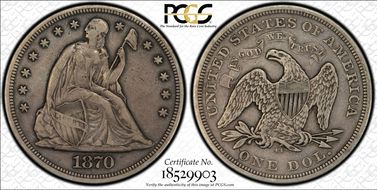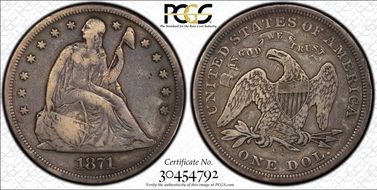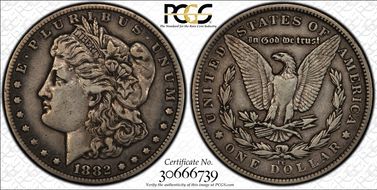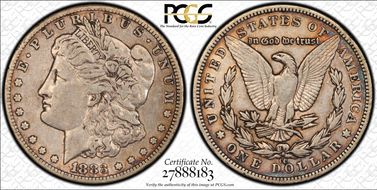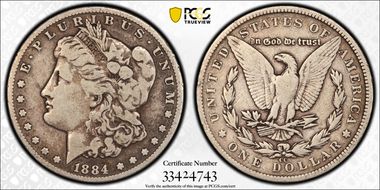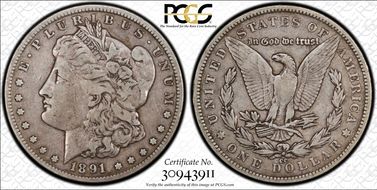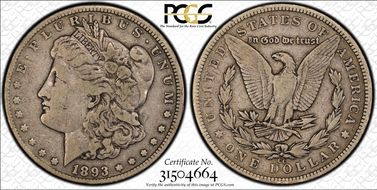Carson City Silver Dollars Complete 1870-1893 的展示图片库
On February 10, 1871 the Carson City Mint sprung to life, producing 2,303 Liberty Seated Dollars. Whether this example was produced on that day, I do not know, but over the course of the year, only 9,000 or so more were produced. This one, like many that will follow has that beautiful “circulated cameo” look. Whenever it was minted, this coin likely saw extensive use in the Old West. (Mintage 11,758; survivorship in circulated condition estimated at 310-600.)
A miniscule 1,376 Liberty Seated dollars were struck in 1871, of which probably only 75-125 have survived to this day. Why only 1,376 were struck in August 1871 and what happened to them immediately after striking are a mystery, but given that there are circulated survivors and uncirculated examples number in the single digits, it is likely they were all distributed locally. (Mintage 1,376; survivorship 75-125.)
Mintage picked up but only slightly in 1872, creating another scarce and desirable coin for collectors. (Mintage 3,150, survivorship 140-210.)
The 1873-CC is the rarest, and most expensive, of all of the Carson City Silver Dollars. 1,000 were minted in January of 1873 and another 1,300 in March. And then that was it, as the Carson City Mint turned to coining Trade Dollars for export to the Orient. Survivorship is tiny, less than 100 in all circulated grades. Some have speculated that the second group of 1,300 minted in March were quickly melted when the Coinage Act became law on April 1, or were turned in to be made into Trade Dollars. Whatever the reason, the 1873-CC Seated Liberty Dollar is recognized as a true rarity in any grade. (Mintage 2,300; survivorship 60-90.)
Produced for trade with China, most were transported by horse and wagon from Carson City to Virginia City, then by rail to San Francisco, where they were loaded onto ships headed to Asia. Most made it across the sea to China, although some circulated locally. This example, which I purchased from a Stacks-Bowers auction, is one that apparently stayed in the United States. The 1873-CC is one of the keys of the Trade Dollar series. (Mintage 124,000; survivorship 1-2,000.)
What makes the 1876-CC particularly interesting is that there are three very distinct reverse types: Type I; Type I Double Die Reverse (DDR); and Type II. Type II is the more common of the three. The Type I DDR is the most famous, with an easily seen doubled reverse, and prices for the DDR are significantly higher. However, even though it is priced the same as the Type II, the Type I without the DDR, like this one, is actually the rarest of the three. (Mintage 509,000; survivorship 1,500-2,500.)
This is a nice, circulated example of a Trade Dollar that remained in the United States. (Mintage 534,000; survivorship 400-800.)
Shortly after the last of the Trade Dollars were minted, the Carson City mint began to churn out Morgan Dollars. All told, over 13.8 million were minted in Carson City, 3 times the amount of Trade Dollars and 725 times the number of Liberty Seated Dollars. Some of the 78-CCs were released locally, but many were shipped east. The 78-CC is one of the more available of the CC Morgan Dollars. (Mintage 2.2 million; survivorship in circulated grades is about 75-125,000.)
The 79-CC is one of the scarcest of the early Morgan years (1878-1885.) Only 756,000 were minted and only about 1500-3000 survive.
591,000 were minted, but 96,000 were melted at the mint because they were underweight, leaving a net mintage of 495,000. Survivorship in circulated grades is 10-20,000, although several hundred thousand exist in Uncirculated. It is quite possible that most of the 1880-CCs minted over 135 years ago still exist today.
Only 296,000 were minted by April 1, 1881, when coinage of silver dollars was suspended for the year. Nearly all remained in the mint vault until 1885 when they were shipped to U.S. Treasury Department facilities in Washington, D.C. and San Francisco. Only a very few were released locally, including this one. Circulated survivorship is around 3,500-6,000. Most of the original mintage survives to this day in Uncirculated condition.
Production cranked back up to over 1.1 million in 1882, but again most were shipped to Treasury facilities. A few were released sporadically starting in the 1940’s. Most circulated ones, of which there are an estimated 8-16,000, are either very worn, or very lightly worn; those lightly worn were likely released in the 1940’s, 50’s and 60’s. Still, by 1964 over half of the original mintage remained in Treasury vaults in Washington. Given the crusty old toning and the wear on this VF-30 example, this one was probably released locally in 1882.
1883 was another year of high silver dollar production at the Carson City mint, over 1.2 million silver dollars were produced. And again, as in the preceding years, most were put into storage. In fact, the GSA population was over 750,000 meaning that over 60 percent survived until the GSA sales in the 1970s. This one may have spent some time in a cardboard album after circulating extensively, as rose and blue toning is just starting to peek out from around the rims.
Almost every single one of the over 1.1 million silver dollars minted by the Carson City mint in 1884 stayed in vaults. A few were purportedly paid out in 1938-1939, but even as late as 1964, approximately 85 percent of the original mintage remained in U.S. government vaults. That’s what makes well-worn examples like this F-15 specimen so difficult to find.
The 1885-CC is the rarest circulated Carson City Morgan Dollar and one of my favorite all-time coins. Few were made, only 228,000, and only a handful made it into circulation. It is a challenge to find a nice, circulated example. The photo does not quite do this coin justice as it is darker, and more original looking in hand. Bowers estimates 2-4,000 exist today in circulated condition; most of the original mintage still survives today in Uncirculated condition.
After a hiatus of four years, the Carson City mint sprang back to life and began producing cartwheels again. But not many --only 350,000—most of which it is believed were eventually melted. Approximately, 3,500-7,000 survive in circulated grade. The 1889-CC is the most expensive Carson City Morgan Dollar. This coin is the first Morgan I purchased for this collection, and originally it had a CAC sticker, but I lost that when I sent it in to be TrueViewed. A beautiful coin, with the perfect circulated cameo look.
The 1890-CC is fairly common and appears to have circulated extensively in the 19th and 20th centuries. Several bags of 1,000 coins were said to have been released in 1942 and 1943, to circulate out west. Despite the fact that they are common, this particular one was the last coin I acquired for my Carson City Silver Dollar set. I imagine that because they are so common and their value is relatively low, few are sent to PCGS for encapsulation. 2.3 million were minted, an estimated 80-160,000 exist today.
Also fairly common is the 91-CC, many are believed to have been put in circulation shortly after being minted. More were later released in the 1920’s, 30’s and 40’s. Few, if any, were left in storage by the 1960’s. Mintage 1.6 million, about 90-170,000 exist today.
In some ways, the 1892-CC is a sister to the 1891-CC. Like the 1891-CC, it is fairly common, with almost 1.4 million minted and 75-140,000 still around today. Most were also circulated out west immediately after striking, more trickled out during the next few decades.
Following repeal of the Sherman Silver Purchase Act, Silver Dollar production was suspended. The Carson City mint was deactivated, reduced to an Assay Office. And although the nation soon resumed production of Silver Dollars, the Carson City Mint never reopened. As such, the 1893-CC is a scarce date and popular with collectors; 677,000 were produced that final year of which 4,500-9,000 survive. I purchased this one raw at a Baltimore Coin show. I hope you have enjoyed this tour through Carson City Silver Dollars, it has been quite a collecting adventure!




















